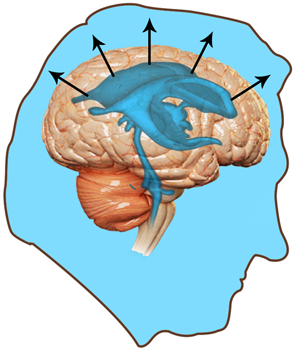
What is Pseudotumor Cerebri/Idiopathic Intracranial Hypertension?
Pseudotumor cerebri means “false brain tumor”, as its symptoms are similar to brain tumor symptoms. It is a brain disorder in which the pressure inside your skull (intracranial pressure) increases, causing headaches and vision problems. Pseudotumor cerebri is also known as idiopathic intracranial hypertension and is more common in obese women.
What are the Causes of Pseudotumor Cerebri?
The exact cause of pseudotumor cerebri is not clear. However, it may develop due to the accumulation of excess cerebrospinal fluid (CSF) inside the skull. This fluid protects your brain and spinal cord and is normally absorbed into your bloodstream. When the CSF is not fully absorbed into the bloodstream, the constant increase in its volume builds up excess pressure inside your skull.
What are the Risk Factors for Pseudotumor Cerebri?
People with the following conditions are at an increased risk for pseudotumor cerebri:
- Obesity/being overweight
- Kidney disorders
- Addison’s disease, a condition where your adrenal glands don’t produce the normal quantity of hormones
- Sleep apnea, a condition where you suffer from phases of stopped breathing during sleep
- Developmental abnormalities/ birth defects
- People using medications like steroids, birth control pills, tetracyclines (an antibiotic) and excess vitamin A are more susceptible to pseudotumor cerebri.
What are the Symptoms of Pseudotumor Cerebri?
The common symptoms of pseudotumor cerebri include:
- Headaches that originates behind your eyes that may worsen at night
- Dizziness
- Vision problems like blurred vision, double vision or permanent loss of vision
- Ringing in your ears
- Pain in your back, neck, or shoulders
- Nausea
How is Pseudotumor Cerebri Diagnosed?
Your doctor will review your medical history and examine your symptoms. The following diagnostic tests are commonly ordered:
- Vision examination to detect abnormal blind spots
- Eye examination to check for swelling of the optic nerve at the back of your eye (papilledema)
- Imaging tests such as X-ray, CT or MRI scan to obtain a detailed image of your brain
- Lumbar puncture, also known as a spinal tap, to determine the pressure inside your skull. For this, your doctor will collect a fluid sample from the vertebrae in your back through a special needle.
What are the Treatments for Pseudotumor Cerebri?
The different treatments to reduce or control the symptoms of pseudotumor cerebri include:
Non-surgical Methods
- Glaucoma drugs to reduce the production of cerebrospinal fluid in your brain
- Migraine medications to provide relief from headache
- Diuretic medications to make you urinate more often and help relieve the pressure of body fluids overall, thereby reducing intracranial pressure.
Surgical Methods
Your surgeon may try to reduce the excess pressure in your brain or eyes through the following approaches:
Optic nerve sheath fenestration: In this procedure, the excess cerebrospinal fluid is drained by making a cut in the membrane around your optic nerve.
Spinal fluid shunt: In this procedure, a thin tube called a shunt is inserted in your brain or lower spine to allow drainage of the excess CSF from the brain into your abdomen.
Prevention of Pseudotumor Cerebri
You can reduce your chances of developing a pseudotumor cerebri by:
- Maintaining a healthy weight.
- Consuming a nutritious diet that includes plenty of vegetables, fruits, and whole grains.
- Doing regular exercise such as a daily brisk walk.
